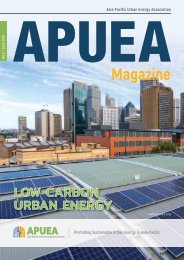APUEA Magazine-no.6 September 2019
Create successful ePaper yourself
Turn your PDF publications into a flip-book with our unique Google optimized e-Paper software.
<strong>APUEA</strong> <strong>Magazine</strong> | No.6 / <strong>September</strong> <strong>2019</strong><br />
required for economic viability. Large separation and thus<br />
transmission costs between potential geothermal resources<br />
and existing or planned population centres hindered viability.<br />
Direct-use application in pools and hot springs is experiencing<br />
significant growth. Australia’s longest-standing, albeit<br />
presently decommissioned direct-use system at Portland<br />
Victoria garners enthusiasm from local government but<br />
requires state/federal support to finance re-commissioning.<br />
Direct-use systems have been installed in 13 aquatic centres<br />
in Western Australia and GSHP applications include housing<br />
estates (e.g. ~900 homes in Western Sydney, NSW),<br />
government buildings (e.g. Geoscience Australia), aquatic<br />
centres (particularly in Western Australia), libraries, schools, a<br />
prison, a substation, community centres, and ski lodges.<br />
Q: What are the different types and capacities of<br />
geothermal systems installed in Australia?<br />
Direct-use and GSHP systems range in capacity from a few<br />
kWt in a residence to a few hundred kWt for commercial<br />
buildings and aquatic centres to 1 MWt for Geoscience<br />
Australia to 72 MWt in a district energy system at Barangaroo<br />
(Sydney, NSW). Over 99% of GSHP systems globally involve<br />
circulation of water (sometimes with antifreeze if required)<br />
through High-Density PolyEthylene (HDPE) pipes inserted and<br />
grouted vertically, diagonally, or horizontally in the ground or<br />
in a pond, lake or river. A portion of the remaining 1% of GSHP<br />
systems circulate refrigerant under pressure through copper<br />
pipes likewise inserted and grouted – those with loop lengths<br />
below 30m are referred to as Direct Exchange (DX) whilst<br />
those with lengths above ~50m Deep-Well Direct Exchange<br />
(DWDX). Australia has an anomalous proportion of DX/DWDX<br />
systems.<br />
Q: With all these ups and downs, does the<br />
geothermal industry have a future in Australia?<br />
Gas prices are projected to continue to rise in Australia and<br />
this is projected to motivate further uptake of direct-use and<br />
GSHP systems. AGA’s census indicates a near doubling of<br />
direct-use and GSHP installed capacity to 151 MWt over the<br />
coming 5-10 years. Further likely developments in Australia’s<br />
geothermal industry include: small Organic Rankin Cycle (ORC)<br />
electricity plants in western Queensland up to ~1 MWe;<br />
establishment of additional hot-spring spas; district-heating<br />
systems in a new development or precinct; and further<br />
direct-use application in aquatic centres (mostly in Western<br />
Australia). Geothermal power plants on the horizon include a<br />
310 kWe ORC power plant in Winton Queensland, a small plant<br />
in Thargomindah and possibly others in Quilppi, Normanton<br />
and Longreach (all Queensland).<br />
Q: Are there subsidies and government support for<br />
geothermal installations?<br />
There is no national policy targeting update of geothermal<br />
systems. Australia’s Renewable Energy Target (RET) of 33,000<br />
GWh/yr is already met by existing and planned solar and wind<br />
projects leaving little incentive for geothermal projects.<br />
Further, GSHPs are not included in the RET despite legacy<br />
inclusion of Solar hot water and Air Source Heat Pumps<br />
(ASHPs) and a number of years of lobbying by peak<br />
geothermal industry bodies. Selected state and federal<br />
programs have funded geothermal projects over the last<br />
decade: e.g. Victorian Government AU$1.6 million to University<br />
of Melbourne, Direct Energy & Geotech; ARENA AU$500k to<br />
Climate-Kic Australia for a study of Deep Well Direct Exchange<br />
(DWDX) GSHPs in a housing development in Western Sydney;<br />
and Federal (CEEP) and Western Australian (LEED) Government<br />
funding of $1.156 million for a GSHP, solar PV and solar-thermal<br />
retrofit to Kalgoorlie’s aquatic centre and $2 million for<br />
Mandurah’s aquatic centre. Green building requirements are<br />
driving specification of geothermal systems in government<br />
and allied buildings.<br />
Dr Donald Payne with the Minister for the Environment<br />
and Heritage, Albert Paul Jacob, during the<br />
inauguration of geothermal system for Kalgoorlie<br />
Goldfield Oasis Leisure and Aquatic Centre<br />
Geo Radial Drill (GRD) for Radial Drilling<br />
27




